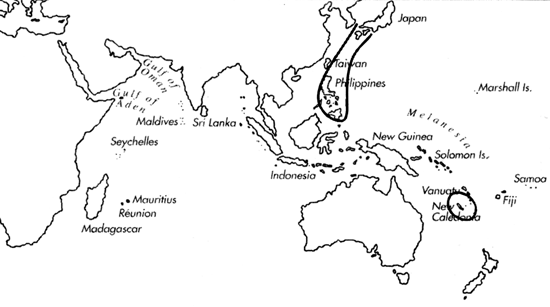Range: Japan, Philippines, New Caledonian area; possibly also S. E. Pacific.
Description: Moderately large to large, solid. Last whorl conical, ventricosely conical or slightly pyriform; outline convex adapically, straight to concave below. Shoulder rounded, occasionally indistinct. Spire of moderate height to high, outline nearly straight or slightly sigmoid, occasionally slightly concave. Larval shell of 3 or more whorls, maximum diameter 1-1.1 mm. First 4-7 postnuclear whorls tuberculate. Teleoconch sutural ramps flat, slightly concave or sigmoid in later whorls, with a spiral striation. Last whorl with fine spiral ribs at base.
| Shell Morphometry | ||
|---|---|---|
| L | 52-114 mm | |
| RW | 0.15-0.33 g/mm | |
| (L 52-81 mm) | ||
| RD | 0.54-0.63 | |
| PMD | 0.78-0.87 | |
| RSH | 0.16-0.28 | |
Ground colour creamy-white to cream. Last whorl with a broad adapical violet-brown or brown spiral band and often one or several similarly coloured bands of varying widths below; bands sometimes irregularly interrupted. Apex white. Later sutural ramps variably maculated or overlaid with brown to violet-brown. Aperture light to pinkish brown.
Periostracum olive, thin, translucent, smooth.
Habitat and Habits: In 180 to 550 m.
Discussion: C. profundorum is similar to C. smirna, which differs in its shoulder having a prominent edge, its flat late sutural ramps, and in the simple pattern of its last whorl with 2 pale spiral bands on the white ground. Shells of C. smirna from New Caledonia and shells of C. profundorum from New Caledonia can be distinguished by their shape (RD 0.49-0.53 vs. 0.62-0.63), relative spire height (RSH 0.21-0.28 vs. 0.16-0.17), and colour pattern. For comparison with the similar C. ikedai, C. scopulicola, and C. darkini, see the Discussions of those species. C. lani is a smaller species (to 54 mm) with a narrower, more conical last whorl (RD 0.50-0.55; PMD 0.84-0.89) with straighter outline, flat late sutural ramps and aplain brown colouration with white spots. C. soyomaruae (Pl. 27, Fig. 17) was assigned to C. smirna by Richard (1990), although the latter species has a less ventricose and distinctly narrower last whorl (RD of holotypes: 0.51 vs. 0.56). We consider C. soyomaruae a colour form of C. profundorum with a more prominent, darker brown banding, because all its other conchological characters fall within the range of variation of the latter species

C. profundorum range map
This section contains verbatim reproductions of the accounts of 316 species of Conus from the Indo-Pacific region, from Manual of the Living Conidae, by Röckel, Korn and Kohn (1995). They are reproduced with the kind permission of the present publisher, Conchbooks.
All plates and figures referred to in the text are also in Röckel, Korn & Kohn, 1995. Manual of the Living Conidae Vol. 1: Indo-Pacific Region.
The range maps have been modified so that each species account has it own map, rather than one map that showed the ranges of several species in the original work. This was necessary because each species account is on a separate page on the website and not confined to the order of accounts in the book.